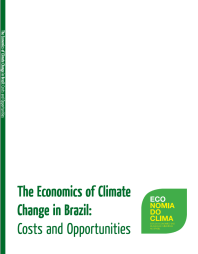
The Economics of Climate Change in Brazil: Costs and Opportunities

Executive Summary (excerpt)
For the first time in Brazil, a large interdisciplinary team, comprised primarily of scientists and economists from leading research institutions in the Country, was brought together to develop projections for various sectors. The starting point was computational models that provided projections on future behaviour of the climate within the national territory, including aspects such as temperature and rainfall levels. These projections were fed into models to simulate some strategic segments of the economy, and they translated the expected impacts on each sector into economic terms according to two potential future climate trends developed by the IPCC – scenarios A2 and B2.
These IPCC climate trends are based on the hypothetical future behaviour of the global economy. This study makes an attempt, to the extent possible, to simulate the future behaviour of the Brazilian economy that is consistent with the same hypotheses made by IPCC in relation to the global economy. The scenarios that were generated for the Brazilian economy are called A2-BR, which was simulated with and without climate change according to IPCC’s A2 climate scenario; and scenario B2-BR, which was also simulated with and without climate change according to IPCC’s B2 climate scenario. They represent future trends for the Brazilian economy assuming that the world will evolve globally according to IPCC’s (economic) assumptions contained in climate
scenario A2 and climate scenario B2 [1].
Although the climate-related problems associated to global warming are long term issues, the year 2050 was used as the basis for simulations, thus excluding the most serious effects on productivity and growth, which will be felt more intensely in the second half of the 21st century. This was necessary because the uncertainties involved – mainly macro-economic uncertainties – were still very significant and the database did not support longer-term projections. Some of the sector-specific analyses, however, go beyond 2050. In addition to this time constraint, the simulations in this study focused on the average behaviour of the variables. This was due to the difficulty in using the models to obtain adequate renditions of the uncertainties involved in extreme climate change situations.
- Issues:
- Climate Change, Economics
- Region:
- Latin America
- Country:
- Brazil
- Year Published:
- 2011
- Authors:
- Sergio Margulis, Carolina Burle Schmidt Dubeux, Jacques Marcovitch
- Institution:
- Universidade de São Paulo - USP

